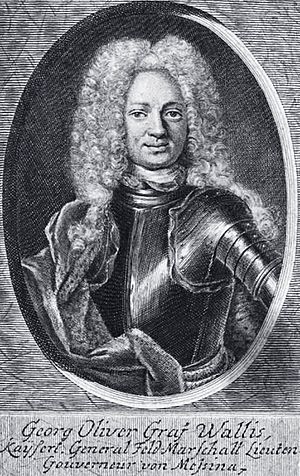George Olivier, count of Wallis facts for kids
Quick facts for kids
George Oliver Walsh, count of Wallis
|
|
|---|---|
 |
|
| Born | 1671 Vienna |
| Died | 19 December 1743 (aged 71 or 72) Vienna |
| Allegiance | Holy Roman Empire |
| Service/ |
Army |
| Years of service | 1690–1740 |
| Rank | Field Marshal |
| Commands held | Mainz (1731–34) |
| Battles/wars | Great Turkish War (Zenta), War of the Spanish Succession, Ottoman–Venetian War, Austro-Turkish War (Petrovaradin), War of the Quadruple Alliance, Anglo-Spanish War, War of the Polish Succession, Austro-Turkish War (Grocka) |
George Oliver Walsh, Count of Wallis (1671 – 19 December 1743) was an important military leader. He was a field marshal, which is a very high rank in the army. He served the Holy Roman Empire and the Kingdom of the Two Sicilies. He was also the last ruler of the Habsburg Kingdom of Serbia for a short time.
George Oliver was born in Vienna, Austria. His family was originally from Ireland. He became famous for capturing the city of Messina in Sicily. He led armies in different places like the Rhine river, Italy, and Hungary. However, he lost a very important battle called the battle of Grocka in 1739. This loss led to a peace treaty that was not good for Austria. Because of this, he lost his high position.
Family Background
His Ancestors
George Oliver's family came from Ireland. His ancestor, Richard Walsh, was one of the first Irish officers to serve in the imperial army in 1632. Richard was hurt in a battle and died that same year.
Richard's oldest son, Theobald, went back to Ireland. He used the family name Walsh. But his younger son, Olivier, stayed in the Austrian army. He started the Austrian part of the Walsh family, who became known as Wallis. Olivier died in 1667 as a major general.
George Oliver's father was Ernst Georg Wallis. Ernst Georg died in 1689. George Oliver also had an older brother named Franz Paul.
His Marriage
George Oliver of Wallis married Countess Maria Antonia von Götzen. After she passed away, he married Countess Maria Theresia Kinsky von Wchinitz and Tettau. He had one son, Georg Stephan, who inherited his titles.
His Military Life
After his father died in 1689, George Oliver became a page at the court in Vienna. A page was a young assistant to a royal family. One year later, he joined the army as a lieutenant.
In 1697, he fought as a captain at the battle of Zenta. During the War of the Spanish Succession (1701–1714), he served in northern Italy. He became a colonel in 1703. From 1707, he helped conquer Naples. He also served in Spain until 1713. By the end of this war, he had become a lieutenant field marshal.
He fought again in the Ottoman–Venetian War (1714–1718). He served under Prince Eugene of Savoy at the Battle of Petrovaradin in 1716. He also helped in the sieges of Temesvár and Belgrade. A siege is when an army surrounds a city to try and capture it.
The next year, he led three regiments in Naples. In the War of the Quadruple Alliance (1718–1720), he fought in Sicily. He was hurt in the battle of Messina. After that, he was in charge of the fortress in Messina until 1727.
He then returned to Austria. When another war threatened, the Holy Roman Emperor sent him back to Sicily. His job was to get the island ready for defense. But the attack never happened. So, Wallis was relieved of his duties in 1731. From 1731 to 1734, he commanded the fortress at Mainz.
In the War of the Polish Succession (1733–1738), he fought against France in northern Italy. He became a Feldzeugmeister, another high military rank. For a time, he was in charge of the entire Austrian army there and gained some ground.
Governor of Serbia
In the Austro-Russian–Turkish War (1735–1739), Wallis led the Austrian army. He was soon promoted to field marshal. In the last year of the war, he was the main commander of the Austrian army. However, he lost the very important battle of Grocka on 22 July 1739.
Just one week after this battle, Austria had to sign the Peace of Belgrade. This treaty meant Austria lost a lot of land to the Ottoman Empire. Wallis was the last governor of the Kingdom of Serbia. He was governor from November 1738 until Serbia was given back to the Ottoman Empire in late 1739. This was part of the Treaty of Belgrade.
Serbia had been part of the Habsburg empire since 1717. Before that, it was part of the Ottoman Empire.
Wallis was held responsible for the defeat at Grocka. He faced a military trial with other generals. On 22 February 1740, he was sentenced to be imprisoned. But when Emperor Charles VI died, Maria Theresa of Austria pardoned him in November of the same year.
He spent his last years on his family's lands. The government in Vienna often asked him for advice on military matters. However, the war against the Turks had damaged his excellent military reputation.

